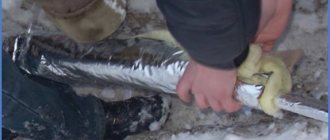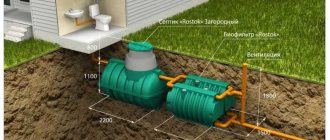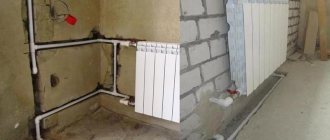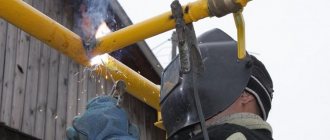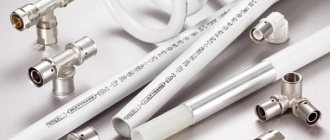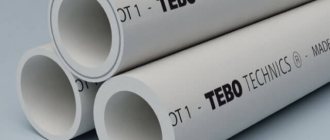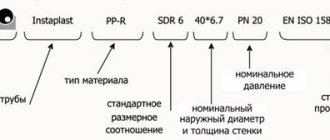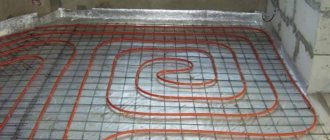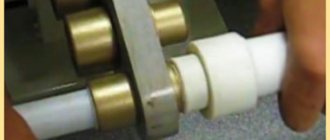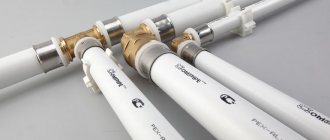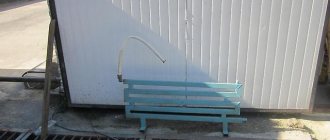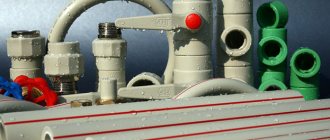Reducing heat losses in heating communications of enterprises, utilities and private homes allows you to save significant financial resources on heating the coolant, so any methods of thermal insulation of pipelines are always relevant. In heating systems of private houses, the main way to maintain the temperature of the coolant in the system is thermal insulation for heating pipes; when used, it is installed on the outer surface of the pipeline.
It is useful for any homeowner whose heating boiler is located at some distance from heat exchange devices (for example, in a separate utility room on the street) to know the main types of heat insulators used to protect pipelines from environmental influences and how to insulate heating pipes. Depending on the material used to make the thermal protection, various methods of its installation are used; most of them are easy to do with your own hands if you know the appropriate technology.
Fig. 1 Thermal insulation for heating pipes in individual houses
Requirements for thermal insulation materials for heating pipes
Thermal insulating materials placed on hot pipes must meet the following requirements:
- Have low thermal conductivity - the lower its value, the more efficiently the shell retains heat. The material’s high resistance to heat loss helps save money on fuel for boilers.
- Heat resistance to high temperatures is the main requirement for an insulating coating; it should not melt or decompose when the object is heated to a boiling water temperature of 100 ° C.
- Water resistance is the main criterion for choosing a thermal insulation material when placed in soil; in this case, an insulator that is not capable of absorbing water is used.
- Biological resistance is important when using thermal insulators in any conditions; the insulating material should not be an environment for the development of various types of bacteria, microorganisms, mold and be of interest to rodents.
- Chemical resistance is also beneficial to insulating materials when installed under soil containing a wide range of chemically active components.
- The service life of thermal protective coatings is important from the point of view of financial savings - the material will not have to be changed too often, incurring additional cash costs for purchasing a new one.
- Physical and mechanical strength is the main criterion for choosing pipe coatings used in underground conditions.
- Environmental cleanliness is important when using thermal insulators indoors; they should not emit harmful chemicals both under normal conditions and when used on hot pipes.
Rice. 2 Thermal insulation of heating pipelines - comparison of thermal conductivity by thickness
"Insulation of heating networks"
INSULATION OF HEATING NETWORKS
Currently, mineral wool, polyurethane foam (PPU), polyethylene foam and other foamed polymer thermal insulation materials and piece products made from lightweight concrete are most often used to insulate heating networks. Mineral wool insulation has low thermal conductivity in a dry state. But due to violations of transportation conditions, storage on a construction site, installation in conditions of high humidity, inaccurate fastening, damage to the vapor barrier film, mineral wool loses its heat-shielding properties, deforms, settles, which leads to the need for repair and replacement of the heat-insulating material. In addition, none of the mineral wools, including basalt wool, are suitable for insulating pipes with a coolant temperature above 250°C, since the impregnating composition decomposes. The polyurethane foam insulation used is mainly suitable for coolant temperatures up to 150°C. If the waterproofing is damaged and water gets in, the polyurethane foam decomposes. Piece thermal insulation materials, capable of providing reliable thermal protection of pipelines for a long time and possessing the necessary heat resistance, are made in the form of shells from perlite concrete, foam glass and other inorganic materials, are quite expensive and require manufacturing in a factory. Cheaper thermal insulation materials include non-autoclaved monolithic foam concrete of natural hardening
- a type of lightweight cellular concrete obtained by hardening a solution consisting of cement, water and a surfactant, or simply foam. The foam ensures the necessary air content in the solution and its uniform distribution throughout the entire mass in the form of small closed cells, which gives the material thermal insulation properties and moisture resistance. Foam concrete has high adhesion to metal and reliably protects metal from external corrosion. The linear expansion coefficient of foam concrete is comparable to the linear expansion coefficient of a steel pipe. Foam concrete can be used for thermal insulation of pipelines, equipment, gas ducts and air ducts located both in buildings and outdoors in non-passable channels and for ductless installation with a coolant temperature from minus 150°C to plus 600°C, including pipelines of heating networks for new construction and renovation work.
If the waterproofing is damaged, foam concrete can pick up up to 22-25% of water, which subsequently evaporates. At the same time, foam concrete, due to the hydration reaction, becomes stronger and retains its heat-shielding properties.
The technology of monolithic non-autoclaved foam concrete involves the use of mobile complexes that make it possible to produce heat-insulating foam concrete with an average density of 150 - 200 kg/m3 directly on site, pouring it into the interpipe space, followed by hardening in natural conditions and forming a durable, heat-resistant heat-insulating layer on the surface of the pipeline. The installation for the production of foam concrete consists of: a low-speed, non-breaking foam mixer, a cyclic mixer, a foam generator for foam production, a compressor and a gerotor pump, which ensures a smooth supply of foam concrete with minimal destruction of air bubbles.
Work can be carried out in winter at temperatures down to -15°C. In this case, it is necessary to ensure a positive temperature of the foam concrete during the first 4-5 hours. This is achieved by using hot water when mixing and insulating the pouring area.
The cost of insulating pipes with monolithic foam concrete is significantly less than insulating with mineral wool or polyurethane foam.
Work production technology
Pipeline sections are cleaned of rust, dust, dirt, oil stains and insulation residues during repair work (Fig. 1).
Rice. 1 Pipeline section
The calculated thickness of the foam concrete layer is created using centralizers (Fig. 2) made of polymer materials (at a coolant temperature not exceeding 120°C) or galvanized steel, installed on insulated pipes at the rate of 1 centralizer per 1 casing (shell).
Rice. 2 Centralizer
Centralizers-plugs are installed at the initial and final sections of the pipeline (Fig. 3). In addition, plugs are installed along the length of the pipeline so that the volume of the limited area corresponds to the volume of the mixer.
Rice. 3 Centralizer-plug
Using self-tapping screws, a casing (shell) made of galvanized steel or aluminum is installed on the centralizers so that the filling hole is located at the top, strictly in the center of the pipe (Fig. 4). The filling holes are subsequently sealed with a waterproofing but vapor-permeable material in order to remove excess moisture from the foam concrete.
Rice. 4 Metal casing (shell) with filling holes.
Foam concrete is poured in 2 stages. Initially, a small volume of the area limited by plugs is filled to control the possible leakage of the foam concrete mixture at the joints of the casing with the fixed supports. Leakage areas are sealed with polyurethane foam. Control of the filling of the space between the pipeline and the metal casing (shell) is carried out visually through the filling holes. The vertical sections of the pipeline are filled in the same way (Fig. 5).
Rice. 5 Vertical section prepared for pouring foam concrete.
Filling on an existing pipeline must be done at a coolant temperature of no more than 60°C. If the temperature is above 60°C, it is necessary to reduce the temperature to that specified for the curing time of the foam concrete (12-24 hours).
The thickness of the foam concrete layer depends on the temperature of the coolant, the temperature zone (for external pipelines) and the diameter of the insulated pipeline. Considering that the unit of measurement for pipeline insulation in standards and prices is accepted as 1 m3 of insulation, and in calculations they often operate on the diameter of the pipeline and its length, below is a table of the ratios of 1 m3 of insulation with the length of the insulated pipeline. The table is designed for insulating external pipelines in temperature zone III with foam concrete with a density of 200 kg/m3 at 4 coolant temperatures.
| Diameter of the insulated pipeline, mm | Pipeline length (m linear) insulated with 1 m3 of monolithic foam concrete grade D 200 at coolant temperature: | |||
| Up to 120°C | 200°C | 300°s | 400°С | |
| 50 | 84,838 | 54,601 | 39,03 | 27,723 |
| 65 | 58,576 | 41,435 | 28,552 | 20,952 |
| 80 | 44,590 | 31,308 | 21,101 | 15,459 |
| 100 | 34,266 | 23,809 | 16,165 | 11,684 |
| 125 | 26,849 | 18,762 | 12,829 | 9,388 |
| 150 | 22,439 | 15,943 | 11,135 | 8,277 |
| 200 | 17,316 | 12,202 | 8,487 | 6,304 |
| 250 | 13,854 | 10,052 | 7,017 | 5,212 |
| 300 | 11,457 | 8,487 | 5,897 | 4,477 |
| 350 | 10,099 | 7,345 | 5,104 | 3,871 |
| 400 | 8,739 | 6,294 | 4,451 | 3,363 |
| 450 | 7,699 | 5,591 | 3,960 | 2,999 |
| 500 | 6,848 | 4,957 | 3,493 | 2,658 |
| 600 | 5,610 | 4,078 | 2,888 | 2,215 |
| 700 | 4,672 | 3,398 | 2,422 | 1,854 |
| 800 | 4,045 | 2,940 | 2,112 | 1,612 |
| 900 | 3,55 | 2,578 | 1,851 | 1,439 |
| 1000 | 3,17 | 2,327 | 1,68 | 1,304 |
| 1400 | 2,19 | 1,601 | 1,193 | 0,927 |
Journal “Pricing and estimate regulation in construction”, November 2009 No. 11
Functions of heat insulators for heating pipelines
If we consider a private house, the heating boiler can be located inside the building in the basement or outside in a separate technical extension. The latter option is often used in the absence of a gas pipeline and the use of solid dirty materials as fuel - coal, firewood, peat, briquettes, pellets.
Many private houses have outdoor baths or saunas, so as not to complicate the design by installing a separate tank for heating water; it is supplied into the premises from the boiler, and the distance between the objects can be quite significant. When deciding how to insulate heating pipes, choose materials that meet the conditions below.
Reduced heat loss
The principle of operation of any insulation is to protect the insulated surface of the protected object from contact with the environment. At the same time, due to the low thermal conductivity of the insulator, heat loss is reduced, and the equalization of air temperatures and the hotter pipeline proceeds much more slowly than in the absence of a heat insulator.
Any heating main can be placed on the surface of the earth or under the ground; in the first case, soft insulation is usually installed for heating pipes in the open air; when placed underground, protection from hard materials is installed due to soil pressure.
Rice. 3 Mineral wool is a popular thermal insulation material for heating pipes
Frost protection
If hot water in an individual heating system is supplied from the boiler to an object located at a considerable distance from it, the water supply is usually laid underground at a distance from the surface below the freezing point. At the same time, it is not always possible to place the pipeline at a sufficient depth, so if the supply of hot water is interrupted for a long time, the remaining and cooled liquid in the pipes may freeze in severe frosts. To protect the underground line from freezing, it can be thermally insulated by placing it in hard shells or soft shells located in pipe channels.
Prevents condensation formation
Construction regulations prohibit the laying of metal pipes in the ground in the absence of insulation or protection of the outer shell with auxiliary materials; the situation is different indoors, where steel, galvanized steel, and copper pipelines are quite often laid. When the heating is turned off, the liquid in the metal pipes cools down and condensation appears on their surface, water drops cause corrosion of the outer wall and, if there is a large accumulation, fall down to form puddles on the floor - this can cause damage to the flooring.
To combat this phenomenon, porous heat-insulating materials for pipelines that are resistant to water or with good vapor permeability are used.
Rice. 4 Foamed polyethylene - thermal insulation for outdoor heating pipes
Protection against thermal burns
In municipal and household services, the temperature of the coolant transported through pipes can reach values close to 100 ° C, so the task of protecting service personnel or residents of a private house from burns when coming into contact with pipes becomes urgent. To do this, their outer walls are covered with thermal protection from various types of heat insulators, the shell of which cannot have a high temperature by definition.
Neutralization of geometric deformations
The ability of all materials to expand when heated is well known, so a hot pipeline, when passing through walls or floor slabs, is placed in steel sleeves of larger diameter. A heat-insulating shell is placed on the pipe, protecting the assembly from hard contact of the enlarged shell with the wall of the sleeve.
When laying pipelines in walls or under the floor, their expansion can lead to cracks in the plaster or screed, so the use of an elastic shell that absorbs part of the thermal expansion helps to avoid problems associated with geometric deformation of the pipes.
Rice. 5 Expanded polystyrene shell - thermal insulation for heating pipes in the ground
Where is thermal insulation needed?
It would seem that the answer is obvious even to people far from heating engineering: in order to prevent heat loss and cooling of the water, it is necessary to insulate the pipes running along the street. That's right, this is the most understandable situation, but there are many other nuances when laying highways within a building.
Often, even thermal insulation of heating pipes in an apartment is required. So, it is necessary to insulate house networks with coolant under the following conditions:
- passage of the supply or return pipeline through cold or poorly heated rooms - attics, basements, built-in garages, and so on;
- when embedding lines and connections to radiators into a wall or floor screed;
- laying pipes behind various screens, inside plasterboard partitions and other similar methods of hidden installation;
- connections from the heating circuits of underfloor heating at the point of their connection to the distribution manifold.
Note. It is also practiced to cover pipelines passing through rooms with excessive heat release from various equipment and household appliances. For example, pipes with thermal insulation will be useful in a boiler room, where emissions from various units inevitably occur and the temperature is unreasonably high.
If the conditions described in the first paragraph are quite clear, then the rest need clarification. The fact is that heating of the rooms is provided by radiators, and the task of the mains and connections is to deliver heat to them. If they are embedded in walls or floors, then thermal insulation is needed for the pipes, otherwise in this case part of the heat will go to heating the building structures, which is not at all necessary. This is especially important when the wall borders the environment.
For reference. The insulation layer also plays the role of a damper when embedding polypropylene pipes, famous for their ability to significantly elongate when heated.
Mains located inside plasterboard partitions and behind screens will increase the temperature in a confined space, which is not practical. To avoid wastage of thermal energy and deliver it to the batteries without loss, thermal insulation for heating pipes is necessary. At the same time, pipelines laid openly in heated rooms do not need insulation, since they still heat the space of these rooms.
As for water heated floors, a situation often arises when many connections from heating circuits converge to the distribution manifold from all rooms. As a result, the distance between them decreases, the concentration of pipes in a small area increases, and the area of the floor in front of the collector begins to overheat. That is why the supply pipes should be insulated in this place.
Types of thermal insulation materials for heating pipes and their characteristics
For thermal insulation of pipes, industry and individual production produce a wide range of materials that differ from each other in their physical and chemical characteristics, scope of application, and installation features.
Mineral wool
Mineral wool fibers are thermal insulators often used in the construction industry; for example, basalt slabs cover the external facades of buildings; in individual houses they are laid under the roof and floors of attics. Often, pipelines are wrapped with soft sheet insulation made of any type of mineral wool, which is fixed with protective films and ties.
Usually they use glass and basalt wool, made respectively from fine glass threads and natural fibers of mountain basalt; in residential buildings, the third type of wool for technical premises - slag - is not used, due to its harmful acidic effect on metals and environmental hazards.
Stone mineral wool is formed from fibers with a length of about 16 mm and a thickness of 4 - 12 microns, it corresponds to the following technical parameters:
- thermal conductivity depends on the form of manufacture and ranges from 0.033 to 0.05 W/m K
- heat capacity: 1059 J/kg K;
- moisture absorption: within 24 hours no more than 0.01% of the volume;
- operating temperature range: from -60 to +450 °C for mineral wool made of glass fibers and from -100 to +700 °C for basalt fiber;
- density depends on the form of manufacture (rolls, plates, cylinders) and ranges from 30 to 225 kg/m3;
- sound absorption coefficient: 0.75 - 0.95;
- flammability class: NG – non-flammable;
- content of binding components (formaldehyde resin): 0.25 - 10% by weight.
Mineral wool is produced in the form of rolls, mats, slabs; for use on pipelines, hard varieties made of basalt are made in the form of shells from individual segments.
Rice. 6 Physical characteristics of various grades of mineral wool
Foamed polyethylene
Materials made from PE foam polyethylene are widely used in the construction industry; it is used for water and sound insulation, as substrates for laminate flooring, insulation outside and inside buildings, and objects of various shapes. Foamed polyethylene has the following physical characteristics:
- thermal conductivity depends on the brand name of the product and is associated with the manufacturing technology (cross-linking) of PE, the range of its values is from 0.30 - 0.55 W/m K;
- operating temperature range: from -60 to +75 °C and above;
- the density of PE depends on the brand and lies in the range of 25 - 100 kg/m3;
- vapor permeability: 0.001 mg/m·h·Pa;
- water absorption coefficient: no more than 1%;
- flammability group: G1 – low flammable, G2 – moderately flammable;
- if there is a foil coating, its reflectivity for infrared radiation: 80 - 97%;
- water absorption: 0.6 - 0.9% of volume
Thermal insulation for heating pipes outdoors and in apartments: characteristics, dimensions
Any pipeline located outside the premises requires insulation. The exception is highways that are laid below the freezing depth. Thermal insulation is also necessary for a pipe located in an unheated room. Insulation allows you to increase the functionality of communication lines and extend their service life. The use of high-quality insulation for pipes allows you to reliably protect them from freezing, reduce heat loss from heating systems and eliminate the formation of condensation.
Why is pipe insulation necessary?
Properly executed thermal insulation allows:
- Reduce unnecessary and unplanned heat losses in heating pipes.
- Minimize the possibility of condensation on the surface of the pipes and inside the insulator.
- Ensure a certain temperature on top of the insulator.
- Increase the service life of pipes by slowing down the formation of rust.
- Protect polypropylene and metal-plastic pipes from mechanical damage.
- Thermal insulation for outdoor heating pipes retains heat and prevents them from freezing in the winter.
How to choose the right material?
As a rule, the choice is based on the following criteria:
- pipe diameter;
- price of thermal insulation;
- under what conditions the operation will take place;
- pipeline length;
- efficiency requirements.
What insulation is used for pipes?
The choice of material for thermal insulation depends, as a rule, on the purpose of the pipeline, the diameter of the pipes and operating conditions. The insulation material must have:
- increased heat saving;
- low thermal conductivity;
- fire resistance;
- resistance to external negative influences;
- ease of installation - for those who want to carry out insulation themselves, this is an important characteristic;
- waterproof;
- durability.
To properly install heating in your home, you must not only purchase pipes and other elements, but also take care to ensure their functionality. So, in order to prevent communications from defrosting under the influence of low temperatures, it is necessary to buy high-quality insulation for heating pipes in advance. Today, the variety of materials for thermal insulation is huge, but before making the final choice, you should familiarize yourself with their quality characteristics.
Most often, thermal insulation for pipes is made of the following materials:
- Polyethylene foam (foamed polyethylene).
- Foam rubber.
- Polyurethane foam.
- Mineral wool.
Thermal insulation is also produced in the form of basalt cylinders.
Polyethylene foam (foamed polyethylene)
Currently, in heating installations, thermal insulation for polyethylene foam pipes is quite widely used. In terms of quality/price ratio, this is the optimal choice. Thermal insulation made of polyethylene foam is produced in 2 main types:
- two-meter tubes;
- canvas.
The material may have a protective coating of polyethylene, aluminum foil, etc.
Polyethylene foam thermal insulation for pipes has the following characteristics:
— Thermal conductivity coefficient (at 40 degrees C) — 0.043 W/m*K.
— Vapor diffusion resistance coefficient — > 3000.
— Temperature range (operating): from -80 to +95 degrees.
- Flammability group - low-combustible materials (G1 and G2).
Thermal insulation for external heating pipes
The insulation of pipes laid outside buildings on the street is exposed to environmental temperatures, direct solar radiation and precipitation, therefore, for their insulation, materials are used that are not influenced by the factors listed above.
From the above list of all insulation materials, polystyrene foam shells can be excluded due to their decomposition under ultraviolet irradiation. Mineral wool and polyethylene foam, which absorb moisture without external protection, can also be excluded from the list of suitable ones.
In municipal and industrial services, for the external laying of heating mains, pipelines in polyurethane foam insulation with a steel shell are used; in everyday life, with the cheapest and most accessible option, the surface of the pipes is wrapped with soft glass wool in combination with an outer polyethylene film, which can be secured with tape.
A slightly more expensive option for household use is the use of soft shells made of polyethylene foam with a foil or PE film surface, which at the same time protects the material from moisture penetration. During installation, the shell is placed on the pipeline, and the joints are wrapped with tape for reliable fastening and sealing from precipitation. Shells made of foiled glass and mineral wool are used and installed in the same way.
Rice. 13 Spraying polyurethane foam
Materials for thermal insulation of pipelines
Currently, the market offers a large selection of materials that can be used for pipeline insulation. Each of them has its own advantages and disadvantages, and in addition, application features. To choose the right heat insulator, you need to know all this.
Polymer insulation
When the task is to create an effective thermal insulation system for pipelines, attention is most often paid to foam-based polymers. A large assortment allows you to choose the right material, thanks to which you can provide effective protection from the external environment and eliminate heat loss.
If we talk in more detail about polymer materials, the following can be distinguished from those available on the market.
Polyethylene foam.
The main characteristic of the material is low density. In addition, it is porous and has high mechanical strength. This insulation is used for the manufacture of cylinders with a cut. Their installation can be carried out even by people far from the field of thermal insulation of pipelines. However, this material has one drawback: structures made of polyethylene foam wear out quickly and, in addition, have poor heat resistance.
If polyethylene foam cylinders are chosen for thermal insulation of pipelines, then special attention must be paid to their diameter. It must match the diameter of the collector. Taking this rule into account when choosing an insulation design, it is possible to exclude spontaneous removal of polyethylene foam casings.
Expanded polystyrene.
The main feature of this material is elasticity. It is also characterized by high strength indicators. Protective products for thermal insulation of pipelines made from this material are produced in the form of segments that resemble a shell in appearance. Special locks are used to connect parts. They have tongues and grooves, which ensure quick installation of these products. The use of polystyrene foam shells with technical locks eliminates the occurrence of “cold bridges” after installation. In addition, during installation there is no need to use additional fasteners.
Polyurethane foam.
This material is used mainly for pre-installed thermal insulation of heating network pipelines. However, it can also be used to insulate household pipeline systems. This material comes in the form of foam or shell , which consists of two or four segments. Spray insulation provides reliable thermal insulation with a high degree of tightness. The use of such insulation is most suitable for communication systems with a complex configuration.
When using polyurethane foam in the form of foam for thermal insulation of pipelines of heating networks, you need to know that it is destroyed under the influence of ultraviolet rays. Therefore, in order for the insulating layer to last a long time, it is necessary to ensure its protection. To do this, apply a layer of paint on top of the foam or lay a non-woven fabric with good permeability.
Fibrous materials
Insulation materials of this type are mainly represented by mineral wool and its varieties. Currently, they are most popular among consumers as insulation.
Materials of this type are also in high demand, like polymer materials. Thermal insulation made using fiber insulation has certain advantages. These include the following:
- low thermal conductivity coefficient;
- resistance of the thermal insulation material to aggressive substances such as acids, alkalis, oil;
- the material is able to maintain a given shape without an additional frame;
- the cost of insulation is quite reasonable and affordable for most consumers.
Please note that during work on thermal insulation of pipelines with such materials, it is necessary to prevent compression of the fiber when laying the insulation. It is also important to ensure that the material is protected from moisture.
Products made from polymer and mineral wool insulation for thermal insulation in some cases can be covered with aluminum or steel foil. The use of such screens reduces heat dissipation.
Thermal insulation for underground heating pipes
GOST 30732-2006 regulates the direct underground installation of heating networks using pipelines with polyurethane foam insulation in a polyethylene shell or sealed channels with a galvanized steel outer protective layer.
For domestic use, laying steel pipes underground with unsealed protection is prohibited; if a pipeline made of PP polypropylene is used, it can be placed in a rigid shell made of regular or extruded PS polystyrene foam, PPU polyurethane foam.
In underground installation, many companies and individuals use a combination of a large-diameter external rigid pipeline and soft polyethylene foam insulation, similar to factory pipes with a PPU thermal insulator and a protective PE sheath. When laying a pipe, a tube made of soft foam polyethylene is placed on the pipeline, secured with tape, and then the resulting structure is inserted into sewer pipes of larger diameter.
Rice. 14 Factory insulated pipe with PPU insulation
Advantages and disadvantages of individual insulation materials
Each of the insulation materials has its own advantages and disadvantages that limit their scope of application; these factors are taken into account when choosing a suitable material for specific conditions.
Fiber wool
Insulation materials made from glass and basalt wool are widely popular among consumers due to their affordability and environmental friendliness, allowing their use inside residential premises. Mineral wool has the following properties:
- Fire-resistant, in case of fire they do not burn and release substances harmful to health; they melt when exposed to too high a temperature.
- Glass wool has low rigidity and easily wrinkles, basalt-based material is stiffer, both types restore their shape after physical impact.
- Mineral wool has a high degree of moisture absorption; because of this disadvantage, shells made of quartz and basalt are not laid directly underground.
- Cotton wool is resistant to most aggressive chemicals and the biological effects of microorganisms, bacteria, fungi, and mold.
- With the exception of slag wool, mineral wools are environmentally friendly natural materials and are safe for human health.
- The material allows air to pass through well and prevents the accumulation of moisture and condensation under its surface.
Rice. 15 Thermal insulation of heating pipes on the street
Soft foam materials
Foamed polyethylene materials for pipeline insulation are produced in the form of tubular shells with a longitudinal slot; their characteristic differences from other types of insulation are:
- Polyethylene in its normal state is harmless to health.
- PE is a chemically and biologically neutral material that is not subject to rotting and resists the appearance of fungus and mold.
- It is moisture-proof, therefore it is often used as vapor and waterproofing in combination with materials with high adhesion (mineral wool).
- Depending on the manufacturer, foamed polyethylene does not support combustion or is slightly flammable (groups G1, G2), while during its ignition substances that are harmful and dangerous to human health are released.
- Foamed polyethylenes and rubber do not shrink and quickly regain their shape after applying physical force.
- Porous rubber is designed to adhere to metal surfaces - thus providing long-lasting and reliable insulation of pipelines.
- For ease of use, some tubes at the longitudinal seam are coated with an adhesive composition (self-adhesive varieties) - this allows you to hermetically isolate objects without cold bridges.
- For external use, tubes made of foamed polyethylene are produced in moisture-protected versions with surface films of various colors.
- Protection made of tubular foam polyethylene is quickly installed, has a beautiful aesthetic appearance of a closed shell, and is therefore widely used in households.
- Due to its low rigidity, the material is used on surface pipelines, popular brands: Energoflex, Jermaflex, Porilex, Vilaterm.
Rice. 16 Application of mineral wool for pipe thermal insulation
Hard shells made of polystyrene foam and polyurethane
Durable and rigid foam plastic, polyurethane shells in the form of a shell from several segments have the following qualities:
- The manufacturing material is biologically inert and resists most aggressive chemicals.
- They do not allow water and moisture to pass through, being vapor and water insulators.
- Polystyrene foam is one of the cheapest materials.
- The material is divided into several groups according to density and rigidity; its extruded variety has the highest parameters.
- Foam plastics are low-flammable; in case of fire they release a large amount of toxic substances in the form of black smoke.
- Due to the destructive effect of ultraviolet radiation on their structure, foam and polyurethane foam shells are recommended for use in underground pipeline laying.
- The low maximum permissible temperature of foam plastic, about 70 °C, is an obstacle to the use of PS in metal pipelines transporting steam or boiling water.
- For outdoor use, given the low strength and fear of ultraviolet radiation by polystyrene foam and polyurethane foam, they are placed in a hard shell made of thin-walled galvanized casings.
- Almost all foam shells are manufactured by commercial small businesses, so if a suitable diameter is not available, the protection can always be made to order in the required size and configuration.
Rice. 17 PE insulation on a heating pipe in a private house
Thermal insulation paint
Domestic manufacturers produce a wide range of thermal paints, the most famous brands being Bronya and Corundum, which have the following advantages and disadvantages:
- Thermal paints are applied to objects by brush or spraying; due to their high adhesion, they adhere well to surfaces made of any materials.
- The cost of paints sold in plastic buckets is too high due to imported raw materials; the price for a 5-liter bucket starts at 1,500 rubles.
- Manufacturer's recommended paint consumption: 1 liter per square meter to obtain an optimal layer of 1 mm thickness.
- Thermal paint is convenient to use on surface hard-to-reach and non-standard sections of pipes, insulation of flange joints, and its underground use is practiced for insulating steel pipelines.
- In addition to thermal insulation, thermal paint provides anti-corrosion protection for objects.
Video description
The process of attaching polyurethane foam to a pipe is shown in detail in the video:
- Permanent , but absolutely hermetic insulation of pipelines is carried out by spraying liquid polyurethane foam using special devices. The layer thickness can be made to any size depending on the climatic conditions in the area of operation. The foam material adheres firmly to the pipes, forming a monolithic layer along the entire length of the pipe, including bends and junctions. It perfectly withstands high and low temperatures and its sudden changes without losing its performance characteristics.
The polyurethane foam spraying method allows you to insulate pipes of various configurations and penetrate into hard-to-reach places Source polyol1.rf
Foamed polyethylene
One of the most popular options used in country houses for thermal insulation of communications is insulation for pipes made of foamed polyethylene. Possessing excellent technical characteristics and ease of installation, it also attracts with its flexibility and a large range of standard sizes. This makes it easy to install it with your own hands on pipes of any diameter and purpose.
The structure of the material consists of many small closed cells filled with air, which is the best heat insulator. Insulation for pipes made of foamed polyethylene is produced in the form of rolls with a length of 10 to 30 meters and a thickness of 3 mm to 2 cm. An even more convenient form of release is two-meter flexible pipes with a wall thickness of 6-25 mm and with an internal diameter corresponding to the diameter of the pipes of the most popular sections: from 18 to 160 mm.
Insulation of the popular Energoflex brand Source znatoktepla.ru
Due to the flexibility and elasticity of the material, which is maintained even at extremely low temperatures, it can be mounted on pipelines of any configuration, regardless of weather conditions. Moreover, it is highly hydrophobic and practically does not absorb moisture, does not rot or collapse.
However, foamed polyethylene is afraid of high temperatures. This is a flammable material that begins to deform already at 90 degrees. Therefore, it is not recommended to use it as insulation for heating pipes, and if there are increased fire safety requirements, its use is generally unacceptable.
Possessing almost the same performance characteristics as polyurethane foam and polystyrene foam, foamed polyethylene is much cheaper, which explains its demand and popularity among buyers. Especially if you need to insulate a pipeline of large diameter and length.
Technology and installation of insulation in everyday life - the best options
Owners of private houses, in order to save money on heating their premises, often have to decide how to insulate heating pipes, considering various types of pipeline insulation. In this case, heating networks can be located anywhere on an individual plot: inside a house or outbuilding, underground or on its surface.
Rice. 18 Applying Warm Paint
Insulation of heating pipes on the street
When deciding how to insulate heating pipes on the street with your own hands, you should first of all consider PE shells of a suitable internal diameter with closed cells. They have a surface film of various colors to cover the longitudinal seam, use tape, staples, self-adhesive types of tubes or any polyethylene glue. Depending on ease of use, PE tubes are purchased in standard lengths of 2 or 10 m; installation work is carried out in the following sequence:
- Clean the pipeline from dirt and dust and put a PE tube of the required size on it; when the seam is about to be coated with glue, it is placed at the top.
- If you use a non-self-adhesive variety, coat the walls of the longitudinal cut with glue and connect them until completely dry, then turn the shell over with the seam down.
- In a similar way, the ends of entire tubes or cut sections are glued together, resulting in a solid and aesthetically beautiful protective shell.
Rice. 19 Installation of PC tubes - main steps
Insulation of heating pipes in an unheated room
Indoors, to insulate pipelines, you can use PE tubes with open cells, which are cheaper than the option discussed above, and options for installing protection with a foil-coated surface layer are also often used. Some manufacturers, for example Energoflex, sell together with their tubes a special glue for joining PE products and an additional tool in the form of a special knife for cutting PE shells and a plastic miter box for cutting tubes straight or at an angle of 45 degrees. PE thermal insulation for heating pipes in an apartment or private house of the Energoflex brand is installed as follows:
- An additional longitudinal seam is cut in the tube using a special knife.
- Pull the seam apart and place the product on the pipe.
- The edges of the seams are secured with special plastic clamps in the form of half rings; to do this, they are connected together and clamping brackets are inserted in the amount of 4 - 5 pieces per linear meter.
- If it is necessary to insulate a corner section of the pipeline, proceed as follows:
- A piece of pipe is inserted into a special miter box and the middle fragment is cut out, and the ends of the joined elements are cut at the desired angle.
- The resulting parts are glued together, coating their edges with special Energoflex glue.
- The resulting corner element is cut lengthwise with a special knife, its longitudinal ends are coated with glue and the parts are placed on the corner of the pipeline; the halves can be wrapped with tape for 2 - 3 hours until the glue dries, after which the shaped unit is ready for use.
Rice. 20 Installation of Energoflex corner insulation element inside the building
The best way to insulate heating pipes on the street - All about insulation and energy efficiency
Creating the right microclimate in any visit is an important task. At the same time, attention is paid not only to the internal space. Insulation of heating pipes on the street is a pressing issue today. The process is influenced by many factors. The stores have a wide range of materials.
Therefore, insulating heating pipes on the street is a set of simple actions that will not be difficult to implement. Each stage of creating thermal insulation must take place in stages. In this article we will consider in detail the issue of insulating heating pipes on the street.
This information will be useful to anyone involved in repairs or construction.
Objectives of thermal insulation material on the street
Each material has its own purpose, which is not just insulation, but also to ensure the safe operation of the entire system. To avoid any difficulties, it is worth analyzing each function and, based on this, make a choice:
- Elimination of heat loss. The main leak occurs when the coolant moves through the pipes. Once in an active environment, the wearer loses its performance. It turns out that the heated water, reaching the radiators, partially reduces its temperature. Depending on the pipe material, the coefficient of heat reaching the end point will be reduced. By creating additional insulation, they prevent heat leakage through walls, air, and pipe material.
- No freezing. Insulating heating pipes outdoors will prevent them from freezing during the cold season. Thus, the coolant will be supplied to the right place with minimal changes in the main indicator.
- Elimination of the formation of water vapor. The creation of condensation on the surface will lead to additional heat loss. By creating a protective barrier, this problem can be easily eliminated.
- Burn protection. Thermal insulation material helps protect against strong thermal influences. When directly touched by a human hand, no serious thermal effects will occur.
- While inside a building, pipes can impact and deform adjacent materials. An additional barrier prevents this.
Insulating heating pipes outdoors is one of the first tasks. Otherwise, it will not be possible to deliver heat to the desired room with a positive degree indicator. Thanks to insulation, you can increase the performance of your heating system. The heat transfer from the batteries will be maximum, since the coolant is as hot as it was initially.
Thermal insulation material must perform serious functions, so high demands are placed on it. This information is in SNiP:
- To achieve the goal, the thermal conductivity of the material must be as low as possible.
- High temperature resistance of the material. The selected insulation must withstand both high and low temperatures without losing its qualities. At the same time, do not react with surrounding objects and do not release harmful substances.
- If the thermal insulation layer gets wet, its qualities will be partially lost. Therefore, its characteristics must include an indicator of water repulsion, otherwise an impact on the pipe cannot be ruled out.
- Vapor permeability. This is important in situations where there is direct contact with water and the protective layer gets wet. It should dry quickly.
- Air permeability – eliminates the appearance of dust, dirt, and condensation under the insulation layer.
- Manufacturers indicate operating periods in the instructions for pipes. The insulation material must fully comply with the deadlines.
Each point is important when insulating heating pipes on the street. If any destruction occurs, it will not be possible to create a protective barrier, and the coolant will quickly cool down.
There is a large assortment on sale to suit every budget. For ease of use, each material is divided by design:
- In rolls. It is sold in the same form; it has one foil side. Fixation is carried out over the entire surface using the winding method, the joints from below, and along the entire perimeter the material is secured with additional fixing rims. The foil side comes out, but it is not a good protection against precipitation, as users say. For this reason, you will have to put something additional on top, for example, create a box or cover the pipe with a casing.
- In the mats. An equally common material, fixation is carried out in the same way. There is an additional layer on top to avoid getting wet and mechanical damage.
- Casing insulation of heating pipes on the street. Most often they do it with their own hands. It can be soft and hard. The last option is a cylinder of the required diameter, with slots for fastening. Soft can be made of flexible material or fabric that has a longitudinal cut. If there is none, then the pipe should be insulated before installing the heating system.
- Liquid masses. Masters claim that they are the most effective and easy to work with. They are applied by spraying or simply painted. Spraying requires special equipment, otherwise a brush or roller.
The majority of manufacturers improve the quality of the material produced to ensure its competitiveness in the market, and therefore the characteristics change. Considering the great demand for goods on the market, it is always easy to select the material for a specific type of work.
